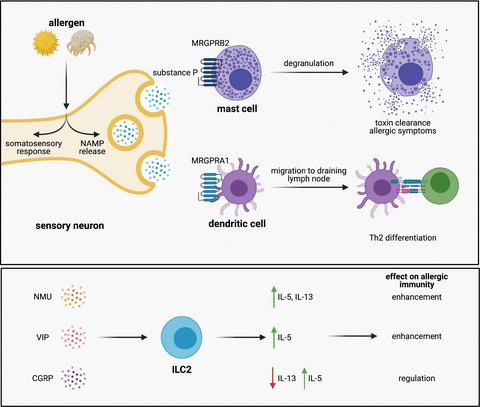当前位置:
X-MOL 学术
›
Immunol. Cell Biol.
›
论文详情
Our official English website, www.x-mol.net, welcomes your
feedback! (Note: you will need to create a separate account there.)
A decision tree model for neuroimmune guidance of allergic immunity
Immunology and Cell Biology ( IF 3.2 ) Pub Date : 2021-06-11 , DOI: 10.1111/imcb.12486 Cameron H Flayer 1 , Caroline Perner 1 , Caroline L Sokol 1
Immunology and Cell Biology ( IF 3.2 ) Pub Date : 2021-06-11 , DOI: 10.1111/imcb.12486 Cameron H Flayer 1 , Caroline Perner 1 , Caroline L Sokol 1
Affiliation

|
The immune system defends the body from infectious and non-infectious threats. Distinct recognition strategies have evolved to generate antigen-specific immunity against pathogens or toxins versus antigen-independent tissue repair. Structural recognition, or the sensing of conserved motifs, guides the immune response to viruses, bacteria, fungi, and unicellular parasites. Functional recognition, which is sensing that is based on the activities of an input, guides antigen-independent tissue healing and antigen-specific Type 2 immunity to toxins, allergens, and helminth parasites. Damage-associated molecular patterns (DAMPs), released from damaged and dying cells, permit functional recognition by immune cells. However, the DAMP paradigm alone does not explain how functional recognition can lead to such disparate immune responses, namely wound healing and Type 2 immunity. Recent work established that sensory neurons release neuropeptides in response to a variety of toxins and allergens. These neuropeptides act on local innate immune cells, stimulating or inhibiting their activities. By integrating our knowledge on DAMP function with new information on the role of neuropeptides in innate immune activation in Type 2 immunity, we describe a decision tree model of functional recognition. In this model, neuropeptides complement or antagonize DAMPs to guide the development of antigen-specific Type 2 immunity through the activation of innate immune cells. We discuss why this decision tree system evolved and its implications to allergic diseases.
中文翻译:

过敏性免疫的神经免疫指导决策树模型
免疫系统保护身体免受传染性和非传染性威胁。不同的识别策略已经演变为产生针对病原体或毒素的抗原特异性免疫抗原非依赖性组织修复。结构识别,或对保守基序的感知,指导对病毒、细菌、真菌和单细胞寄生虫的免疫反应。功能识别是基于输入活动的传感,指导抗原非依赖性组织愈合和对毒素、过敏原和蠕虫寄生虫的抗原特异性 2 型免疫。从受损和垂死的细胞中释放的损伤相关分子模式 (DAMP) 允许免疫细胞进行功能识别。然而,仅 DAMP 范式并不能解释功能识别如何导致这种不同的免疫反应,即伤口愈合和 2 型免疫。最近的研究表明,感觉神经元释放神经肽以响应各种毒素和过敏原。这些神经肽作用于局部先天免疫细胞,刺激或抑制他们的活动。通过将我们对 DAMP 功能的知识与神经肽在 2 型免疫中先天免疫激活中的作用的新信息相结合,我们描述了功能识别的决策树模型。在该模型中,神经肽补充或拮抗 DAMP,通过激活先天免疫细胞来指导抗原特异性 2 型免疫的发展。我们讨论了为什么这个决策树系统会进化以及它对过敏性疾病的影响。神经肽补充或拮抗 DAMP,通过激活先天免疫细胞来指导抗原特异性 2 型免疫的发展。我们讨论了为什么这个决策树系统会进化以及它对过敏性疾病的影响。神经肽补充或拮抗 DAMP,通过激活先天免疫细胞来指导抗原特异性 2 型免疫的发展。我们讨论了为什么这个决策树系统会进化以及它对过敏性疾病的影响。
更新日期:2021-06-11
中文翻译:

过敏性免疫的神经免疫指导决策树模型
免疫系统保护身体免受传染性和非传染性威胁。不同的识别策略已经演变为产生针对病原体或毒素的抗原特异性免疫抗原非依赖性组织修复。结构识别,或对保守基序的感知,指导对病毒、细菌、真菌和单细胞寄生虫的免疫反应。功能识别是基于输入活动的传感,指导抗原非依赖性组织愈合和对毒素、过敏原和蠕虫寄生虫的抗原特异性 2 型免疫。从受损和垂死的细胞中释放的损伤相关分子模式 (DAMP) 允许免疫细胞进行功能识别。然而,仅 DAMP 范式并不能解释功能识别如何导致这种不同的免疫反应,即伤口愈合和 2 型免疫。最近的研究表明,感觉神经元释放神经肽以响应各种毒素和过敏原。这些神经肽作用于局部先天免疫细胞,刺激或抑制他们的活动。通过将我们对 DAMP 功能的知识与神经肽在 2 型免疫中先天免疫激活中的作用的新信息相结合,我们描述了功能识别的决策树模型。在该模型中,神经肽补充或拮抗 DAMP,通过激活先天免疫细胞来指导抗原特异性 2 型免疫的发展。我们讨论了为什么这个决策树系统会进化以及它对过敏性疾病的影响。神经肽补充或拮抗 DAMP,通过激活先天免疫细胞来指导抗原特异性 2 型免疫的发展。我们讨论了为什么这个决策树系统会进化以及它对过敏性疾病的影响。神经肽补充或拮抗 DAMP,通过激活先天免疫细胞来指导抗原特异性 2 型免疫的发展。我们讨论了为什么这个决策树系统会进化以及它对过敏性疾病的影响。











































 京公网安备 11010802027423号
京公网安备 11010802027423号